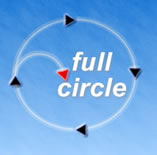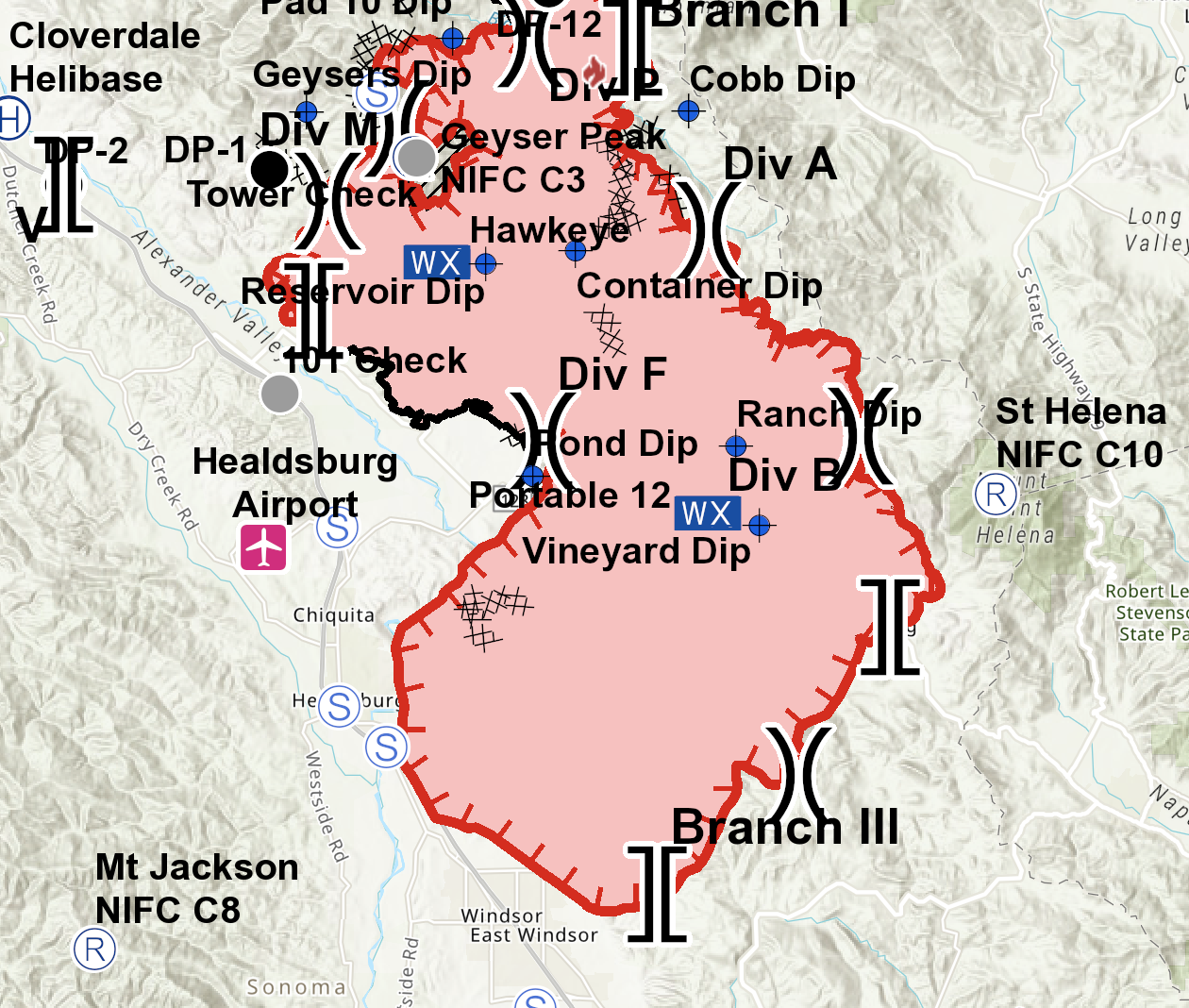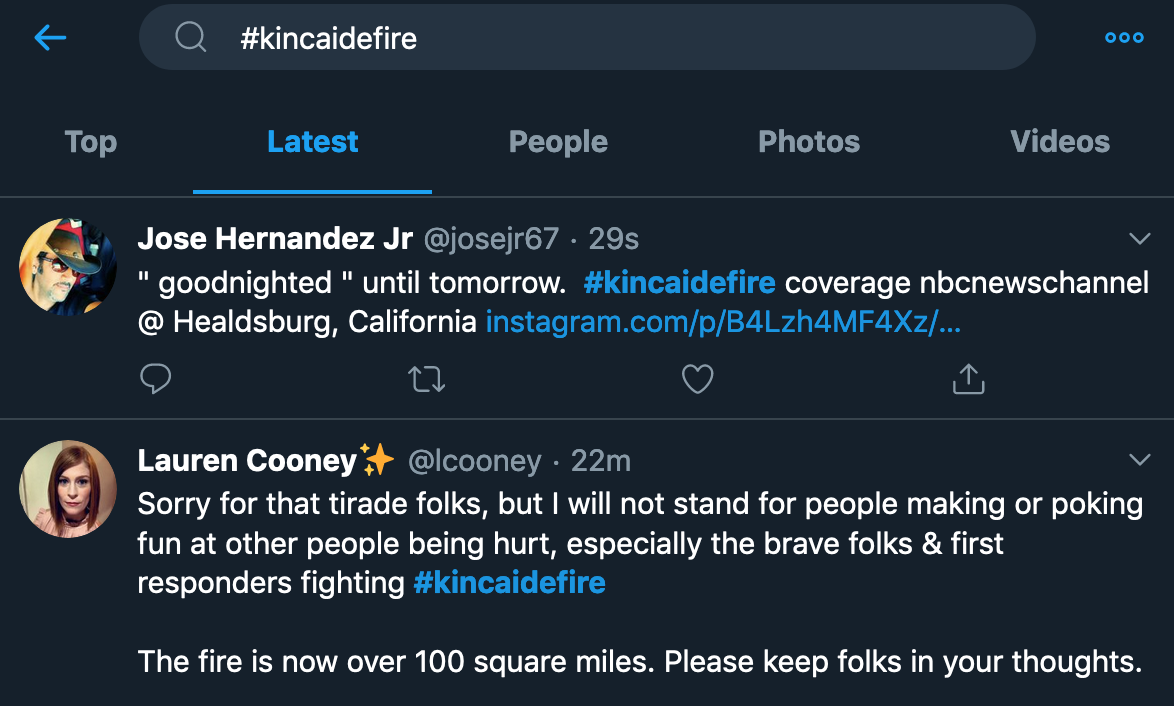
Feature: Finding Real Time Information

When it is needed, finding up-to-date information using a search engine can be challenging. Search engines don't retrieve "live" information from the Internet, instead they retrieve information stored in databases which could be minutes old or days old. Robotic programs called 'spiders' or 'search bots' mine live information and store it for retrieval. Unfortunately, when you query a search engine you get only the database contents.
This makes certain types of time-sensitive searches difficult to do. Recent wildfires in California are one example. Whether you live near a threatened area or have loved ones that do, unless you are on the ground the information you have is likely old. Conditions may change by the minute. Personal safety may hinge on knowing what's happening now.
Searching for Kincade Fire produces plenty of results, but time stamps show the problem:
Is this information too old to be used for decision-making? Probably. A lot can happen in two hours when gale-force winds are fanning the flames.
When you click a link like the one above, you are no longer in Google's database, you are on a live site. The information may not look like the search abstract (snippet) because the live Web page was updated since Google crawled it. But once on a live page, browsing--aka clicking links--guarantees you remain in the "now."
This illustrates the problem with finding realtime or reasonably current information. Most of the results are old. How can realtime information be found? Even using a query like realtime Kincade fire map produces questionable results.
Live Streaming
Streaming news casts and Webcams may be the most up-to-date news sources. Streaming video or audio from television and radio stations may be available during an incident. The Kincade fire is being covered by television and radio. To find those sources a query like live streaming Kincade fire may be too specific since a glance at the search results shows a lot of non-streaming information. In that case, a broader focus (hypernyms) may be helpful. The query streaming news san francisco retrieves network stations that stream live. The information may or may not be relevant at the moment--the news may be national not local.
Another source of 'happening now' information is live Webcams, as long as there is one in the area affected. Placement and power outages are variables that limit their effectiveness. One example may be found on this interactive map. Click the red arrow symbol for a live view from a Webcam located at Pole Mountain. Note that this is close to the Pacific coast, not close to the fire.
Almost Live
Some applications are designed to deliver information with minimal delay. Airline ticket sites are a good example. Flight prices can change while you are searching for them. Seat selection can change as other customers book seats. It just takes a page refresh to see that information has changed. If you've ever checked in for a Southwest flight, you know well what real time information looks like. Doppler radar sites display weather conditions up to six minutes after they happen. Stock prices may be displayed in real time if you pay for a subscription. The technology for turning around data quickly is costly, so if you want it, be prepared to pay for it.
Free Subscription Services
For residents affected by wildfires in Sonoma County, smartphone notifications are intended to save lives by providing timely alerts to dangerous conditions. This strategy is recommended wherever you live if you want to receive notifications. Just use a query like (name of city or county) emergency notification to see if such a service is available where you live. Other than the expense of a smartphone, services like these are free.
Official News Sources
A good question to ask when searching for credible information is: Who would know the answer? The answer is usually an expert or someone with first-hand knowledge. Who has the most accurate and current information about California wildfires? Crews battling the blazes have the most current information. They see the fire. They respond to it. They try to stay ahead of it. They report their information to a centralized command. Some people use police and fire scanners to listen to ongoing communications (this information is considered public in the US). Online apps make it possible to listen to live broadcasts from police and fire department feeds using the Internet. Short of going to that length, searching official sites can provide updated information.
CalFire is an agency that coordinates firefighting efforts in California. Their Incident Map shows fire sizes and containment. The image below was last updated six minutes before taking the screenshot.
A quick look at the Healdsburg Fire Department and Sonoma County Sheriff Web pages reveals no information less than five hours old. The Sheriff's Facebook page is updated more often.
Twitter and Social Media
Other sources of 'happening now' information includes Twitter, Instagram, Facebook, etc. The content and quality of the information is only as good as the source who posts it. In the case of the Kincade fire, find an appropriate hashtag and search with it, for example, #kincadefire. See the screenshot below. Note that when this image was captured the latest tweet was 29 seconds old. There could be useful information, but it's typically subjective (reflecting the author's views). The amount of time elapsed between tweets may be an indication that fire activity is slowing down or people aren't paying as much attention or fewer people are on site to witness it--after all, over 100,000 peolpe have been evacuated. Fact is, making objective sense of 'personal snapshots' may be impossible.
To Summarize
The Internet is lightning fast but it's not the only or always the best way to get the freshest information. Database searching is a start but not the finish. Only by browsing can you navigate the live Web. Sometimes it's more expedient to pick up the phone and talk to someone in the know. Other search strategies that include finding authoritative sites, free or paid subscription services and following social media and may also be helpful.

Action Zone: Freshness Challenge
Curriculum: Connections
Suggested curricular uses for Freshness searching and evaluation. Go
Assessment: What Students Know
Using Freshness Challenges to measure students' competencies. Go


